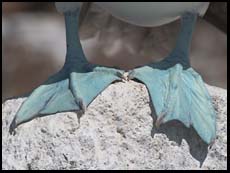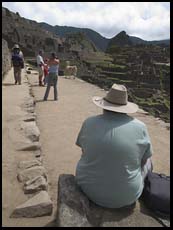
Olympus E1 Review
by Philip Greenspun; created May 2004
Site Home : Photography : Olympus E1 Review
 The 5-megapixel Olympus E1 single-lens reflex digital camera is the basis of a
revolutionary system of compact interchangeable lenses. Imagine that you need a
2x-8x magnification professional quality zoom lens, which translates to 100-400mm
on a 35mm camera. Canon sells a 100-400/4.5-5.6 lens for $1400 that weighs 3 lbs.
For the E1 with its smaller sensor the same magnification is obtained with a
50-200mm lens. Olympus sells one for $900 that weighs 2.4 lbs, is smaller than
the Canon lens, and is more than 1 f-stop faster at 2.8-3.5. Depth-of-field, the
range of distances at which objects are in acceptably sharp focus, relates only
to lens length and aperture. A 400mm lens at 5.6 focussed at 30 feet will render
objects reasonably sharp from 29'9" to 30'3", a 7-inch depth of field. At 200/5.6
the acceptable range is from 28'11" to 21'2", a 27-inch depth of field.
The 5-megapixel Olympus E1 single-lens reflex digital camera is the basis of a
revolutionary system of compact interchangeable lenses. Imagine that you need a
2x-8x magnification professional quality zoom lens, which translates to 100-400mm
on a 35mm camera. Canon sells a 100-400/4.5-5.6 lens for $1400 that weighs 3 lbs.
For the E1 with its smaller sensor the same magnification is obtained with a
50-200mm lens. Olympus sells one for $900 that weighs 2.4 lbs, is smaller than
the Canon lens, and is more than 1 f-stop faster at 2.8-3.5. Depth-of-field, the
range of distances at which objects are in acceptably sharp focus, relates only
to lens length and aperture. A 400mm lens at 5.6 focussed at 30 feet will render
objects reasonably sharp from 29'9" to 30'3", a 7-inch depth of field. At 200/5.6
the acceptable range is from 28'11" to 21'2", a 27-inch depth of field.
The E1 is compact but solidly built and at 23 oz. without batteries weighs
more than many full-size digital SLRs such as the Canon Digital Rebel. The E1
does everything that you'd expect a professional digital SLR to do, including
output images in 12-bit RAW format, and comes with a fairly comprehensive range
of software including Adobe PhotoShop Elements. A body, the 14-54mm/2.8-3.5 zoom
lens (28-108mm 35mm equivalent), and a dedicated accessory flash could be
purchased for about $1350 at in December 2004.
 The E1 is reasonably responsive but nowhere near the state-of-the-art defined by
Nikon digital SLRs. Where a Nikon DSLR can take a photo immediately after being
switched on, the Olympus takes more than two seconds to turn on. If the E1 goes
to sleep it takes more than two seconds to wake up.
The E1 is reasonably responsive but nowhere near the state-of-the-art defined by
Nikon digital SLRs. Where a Nikon DSLR can take a photo immediately after being
switched on, the Olympus takes more than two seconds to turn on. If the E1 goes
to sleep it takes more than two seconds to wake up.
The E1 has the standard four exposure modes: Metered Manual, Aperture-priority, Shutter-priority, and Program autoexposure. There are two control wheels so that you can adjust aperture and shutter speed simultaneously. Program auto isn't as useful as with a Canon SLR due to the fact that you can't simply dial in a bit of exposure compensation but must press a separate shift key and then turn a dial. Shutter speeds range from 60 seconds to 1/4000th of a second.
 The E1 has the standard three focus modes: Manual, Single-shot auto, Continuous
auto. If you dig into the manual a bit you can figure out how to make the
autoexposure lock button on the back of the camera into a "burst of AF" thumb
switch while in Manual Focus mode. Thus you're able to manually adjust focus but
have automatic assistance available when desired. Autofocus performance seems
substantially worse than with the modern Canon bodies, especially in dim light,
and most of the sensor coverage is in the middle of the frame. The in-lens focus
motors seem to be slower and less powerful than the Canon ultrasonic motors. This
is a problem when trying to track a bird in flight, for example. If you aren't
able to keep the bird underneath one of the AF sensors the lens starts hunting
back and forth very slowly.
The E1 has the standard three focus modes: Manual, Single-shot auto, Continuous
auto. If you dig into the manual a bit you can figure out how to make the
autoexposure lock button on the back of the camera into a "burst of AF" thumb
switch while in Manual Focus mode. Thus you're able to manually adjust focus but
have automatic assistance available when desired. Autofocus performance seems
substantially worse than with the modern Canon bodies, especially in dim light,
and most of the sensor coverage is in the middle of the frame. The in-lens focus
motors seem to be slower and less powerful than the Canon ultrasonic motors. This
is a problem when trying to track a bird in flight, for example. If you aren't
able to keep the bird underneath one of the AF sensors the lens starts hunting
back and forth very slowly.
Sensitivity is adjustable from ISO 100-3200 but there is no good reminder of what you've got set and the setting is persistent if you turn the camera off and back on overnight. The "ISO AUTO" setting leaves the sensitivity at ISO 100 regardless of how dim the light gets and how slow a shutter speed is required. It only kicks the ISO up to 400 if you've got a flash attached and your subject is beyond the range of the flash at ISO 100.
Operation is more or less modeless unless you get stuck in a menu confirmation dialog box. If you've pressed the playback button and are reviewing images a quick touch of the shutter release readies the camera to take pictures again.
Viewfinder coverage is very accurate, basically 100 percent, and the eye relief is sufficient for eyeglass wearers. If you are coming to the E1 from a point-and-shoot camera you will be amazed at how much easier it is to compose a photo. If you are coming to the E1 from a high-end film or digital single-lens reflex you will get what you expect from the E1's viewfinder.
The E1 takes Compact Flash cards, both Type I and II. Microdrives work in the camera but operate very slowly if you are taking 10 MB RAW images.
The camera has a 12-picture internal buffer memory for rapid sequence photography. The camera can capture 3 frames per second.
 The camera does not have a built-in flash. Dedicated Olympus accessory flash
units mount in the hot shoe above the viewfinder and the camera is able to
control flash exposure via a through-the-lens sensor. Maximum flash sync speed is
1/180th or all the way up to 1/4000th with the Olympus FL-50 flash. Balancing
flash and natural light is straightforward.
The camera does not have a built-in flash. Dedicated Olympus accessory flash
units mount in the hot shoe above the viewfinder and the camera is able to
control flash exposure via a through-the-lens sensor. Maximum flash sync speed is
1/180th or all the way up to 1/4000th with the Olympus FL-50 flash. Balancing
flash and natural light is straightforward.
The standard zoom lenses focus reasonably close. Olympus makes a Four Thirds-mount 50/2.0 macro lens that functions like a 100mm macro lens on a 35mm camera and focuses down to 1:2. In practice this means you can fill the frame with an object that is 24x36mm in size or just as small as if you were using a 1:1 macro lens on a 35mm camera. With the Olympus EX-25 accessory extension tube you can go down to 1:1 and capture a photo of an object the same size as the E1's sensor (15x20mm).
Ultra wide angle lenses are not available in the Four Thirds mount. The widest lens made by Olympus is an 11-22 zoom, giving the same perspective as a 22-44mm lens on a 35mm camera. In other words there is no equivalent in this format to the 16 or 18mm lenses that are so common in the film world. This is supposed to change in January 2005 with the introduction of a 7-14 zoom, equivalent to a 14mm perspective on a 35mm camera.
Photography in available, i.e., light is a challenge with the E1 because the lenses are two f-stops slower than the standard 50/1.4 from the film world. If you would need ISO 800 film, for example, to go with a 50/1.4 you need ISO 3200 to get the same shutter speed with an f/2.8 lens such as those provided by Olympus. The camera's performance at ISO 3200 is very noisy.
The included Lith-ion battery is adequate for a day of active photography, somewhere between 100 and 200 photos plus review. The E1 cannot run on disposable AA or litium batteries. To recharge the battery you must carry a small travel charger and power cord.
 Olympus includes some very usable image library library management software with
the camera called "Olympus Viewer". To do batch-conversion of RAW images you will
need to spend an extra $150 on "Olympus Studio", which also has a higher quality
RAW-to-JPEG conversion algorithm. Both Viewer and Studio have a nice feature to
support batch renaming of images. You can select all images in a folder or a
group with a single mouse command and then say "prefix these all with 'castle-'
and suffix them with a 2-digit number starting at 01".
Olympus includes some very usable image library library management software with
the camera called "Olympus Viewer". To do batch-conversion of RAW images you will
need to spend an extra $150 on "Olympus Studio", which also has a higher quality
RAW-to-JPEG conversion algorithm. Both Viewer and Studio have a nice feature to
support batch renaming of images. You can select all images in a folder or a
group with a single mouse command and then say "prefix these all with 'castle-'
and suffix them with a 2-digit number starting at 01".
Olympus tosses in a copy of Adobe PhotoShop Elements but you'll need the $700 PhotoShop 8.0 CS version if you want to deal with Olympus RAW Format images.
Olympus Studio allows you to control the camera from a Windows machine including releasing the shutter. The Olympus device driver for the camera crashed my brand-new Tablet PC, however.
Whatever software you choose to use you'll be spending plenty of time post-processing due to the E1's lack of a mercury switch to orient photos. In other words an image captured with the camera held vertically will appear on a computer screen rotated on its side. The original Kodak/Nikon digital SLRs from the early 1990s had this figured out as do most current (2004) Canon point-and-shoot digitals and low-end digital SLRs. Olympus includes a convenient in-camera image rotation capability but this does not affect any JPEGs that will be produced from the camera RAW.
 The E1 that I tested held up quite well in the high Andes mountains, getting
sprayed with sea water in the Galapagos, and getting rained on in the Peruvian
Amazon. Construction seems to be on a par with the semi-pro Canon and Nikon
bodies. The system is not designed for use in a continuous downpour like the
Canon pro gear, though Olympus says that it has a "splash-proof design" for both
camera and lenses.
The E1 that I tested held up quite well in the high Andes mountains, getting
sprayed with sea water in the Galapagos, and getting rained on in the Peruvian
Amazon. Construction seems to be on a par with the semi-pro Canon and Nikon
bodies. The system is not designed for use in a continuous downpour like the
Canon pro gear, though Olympus says that it has a "splash-proof design" for both
camera and lenses.
In 30 days and more than 1000 photos the E1 operating system froze up only once. Switching the camera off then back on did not revive the machine but removal and reinsertion of the battery did.
Sometimes the telephoto zoom lens would click into the mount mechanically but be electrically unavailable to the camera body. A "F--" would appear in the LCD display. Unmounting the lens a quarter turn and clicking it back into the lock always solved the problem.
Here are some things that would be nice for the Olympus E2 digital SLR:
In addition to the E2 Olympus really needs to build a light cheap body to build market share and establish the Four Thirds system as more than a boutique product. Certainly Olympus needs something that is lighter and cheaper than the bottom of the Canon and Nikon lines.
Given that the Four Thirds System is open to multiple suppliers one would expect at least the full range of capability that photographers are able to get in the Canon or Nikon lines. Thus at a minimum the Four Thirds system needs the following:
 Why did Olympus and its partners come up with a new format and lens mount
standard? It all goes back to how integrated circuits ("chips") are fabricated.
Chips are manufactured on wafers ranging in size from 6 to 12 inches in diameter.
Each wafer is supposed to be a flawless silicon crystal but in practice there
will be defects randomly distributed on the wafer. Suppose that you're making
small chips, like the kind that control microwave ovens. You might be able to
make 1000 at a time on a single wafer. Suppose that there are 10 defects in the
wafer. Each one is likely to fall on a different chip and therefore those 10
defects ruin 10 chips. The yield is 990/1000 or 99 percent good chips. Suppose
instead that you're making a huge processor like the latest Pentium, with a die
size of 150 square millimeters (approximately 10x15mm). Perhaps you can only fit
50 of these on a wafer. If the 10 defects fall on 10 different dies the yield of
good chips is only 40/50 or 80 percent. This is one reason that big chips are so
much more expensive than small chips.
Why did Olympus and its partners come up with a new format and lens mount
standard? It all goes back to how integrated circuits ("chips") are fabricated.
Chips are manufactured on wafers ranging in size from 6 to 12 inches in diameter.
Each wafer is supposed to be a flawless silicon crystal but in practice there
will be defects randomly distributed on the wafer. Suppose that you're making
small chips, like the kind that control microwave ovens. You might be able to
make 1000 at a time on a single wafer. Suppose that there are 10 defects in the
wafer. Each one is likely to fall on a different chip and therefore those 10
defects ruin 10 chips. The yield is 990/1000 or 99 percent good chips. Suppose
instead that you're making a huge processor like the latest Pentium, with a die
size of 150 square millimeters (approximately 10x15mm). Perhaps you can only fit
50 of these on a wafer. If the 10 defects fall on 10 different dies the yield of
good chips is only 40/50 or 80 percent. This is one reason that big chips are so
much more expensive than small chips.
Suppose that you decided to make yourself a full-frame sensor for an 8x10 (inch) view camera. You'd only be able to fit one die on even the largest wafer. If there were even one defect on that wafer it would be guaranteed to fall within your sensor chip and ruin it. So your yield would be maybe 1 percent as you produced 100 wafers until you got lucky enough to make a flawless one. The price of that 8x10" sensor would be astronomical.
 What about the 24x36mm frame size of a standard 35mm camera? That's a whopping
864 square millimeters, much larger than any computer chip ever produced, but
certainly small enough that you can fit a handful on a large wafer. Starting in
2002 Canon and Kodak were both able to pull off the manufacturing feat of
producing 24x36mm sensors in reasonably large quantities. The high cost, however,
is reflected in the $4000-7000 cost of the resulting cameras, e.g., the Canon
EOS-1Ds.
What about the 24x36mm frame size of a standard 35mm camera? That's a whopping
864 square millimeters, much larger than any computer chip ever produced, but
certainly small enough that you can fit a handful on a large wafer. Starting in
2002 Canon and Kodak were both able to pull off the manufacturing feat of
producing 24x36mm sensors in reasonably large quantities. The high cost, however,
is reflected in the $4000-7000 cost of the resulting cameras, e.g., the Canon
EOS-1Ds.
Unless the laws of physics are repealed it is always going to be much more expensive to produce a 24x36mm sensor than one that is closer in size to the processor in your desktop computer. The result is that the $800-$2000 Canon and Nikon digital SLRs incorporate smallish sensors that only cover a portion of the 24x36mm frame. Photographers end up lugging around huge heavy expensive lenses that project a very large image, most of which goes unused. It is rather like carrying around Hasselblad 6x6cm lenses to use on a 35mm Nikon. You'll get an acceptable image but also a backache.
Any engineer would look at this situation and say "Why not come up with a
standard reasonable sensor size and then make lenses that are just large enough
to cover that sensor with an image?" That's precisely what the Four Thirds
consortium did. Olympus and Kodak seem to be the originators of the standard but
Fuji, Panasonic, Sanyo, and Sigma have signed on as well according to
http://www.four-thirds.org.
In deciding whether or not to buy an E1 and a few lenses you have to ask yourself "Is this better for me than Canon and Nikon" and "Is this standard going to catch on?"
The cheapest Canon and Nikon digital SLRs are much cheaper than the Olympus E1 and, according to most reviewers, deliver higher image quality. If you're reasonably physically fit and already have a good collection of Canon and Nikon lenses it might be tough to justify spending $5000 for an E1 and a few new-format lenses.
What if you don't have a 35mm lens system already? Canon and Nikon are still better if you have a specialized requirement, e.g., for image stabilization or autofocus tracking of birds in flight. Canon and Nikon also win if you're on a tight budget; the Canon Digital Rebel and a couple of non-professional lenses cost much less than the E1 body alone. The E1 system wins if you're rich and want a compact yet very capable system for general travel photography. It would be a big winner for this application if Olympus made some lenses shorter than 10mm.
There is a danger that the whole system will collapse under the weight of its high prices. It is true that what Canon and Kodak are doing in making full-frame 24x36mm sensors is ridiculous and almost totally impractical from an engineering point of view. On the other hand if they keep doing it year after year they might eventually get really good at it. If Canon or Nikon can produce a $1500 full-frame digital SLR before the Four Thirds system becomes truly popular it is hard to see a vibrant future for the new standard. The lenses will still be compact but due to low production volume they might not be cheap, just as the Four Thirds format 300/2.8 should cost much less than Canon's 24x36mm-coverage 300/2.8 and yet the Four Thirds lens costs nearly twice as much.
[December 2004 update: Canon has come out with its next-generation full-frame digital SLR, the 16 megapixel EOS-1Ds Mark II. It costs $8,000. Kodak's full-frame digital SLRs are still around $4000. Olympus has released the Evolt, an 8-megapixel Four Thirds system camera that sells for $1000 with an included 14-45mm/3.5-5.6 zoom lens (i.e., a cheap consumer zoom lens). The closest equivalent Canon product is a Digital Rebel kit for $870.]
As an engineer I love the direction that Olympus is taking. As with other mid-priced digital SLRs the E1 delivers image quality that is reasonably comparable to 35mm film and therefore good enough for many professional projects. The E1 is compact yet its most important controls can be operated by feel. The E1 has a bright accurate optical viewfinder that makes it easy to evaluate a scene before taking a photo.
The 50-200 at 200mm...
The 14-54mm lens at 14...
The 14-54mm lens at 54...
Text and pictures
copyright 2004Philip Greenspun. All of the images in this review are from a spring 2004 trip to
Ecuador, the Galapagos, and Peru.